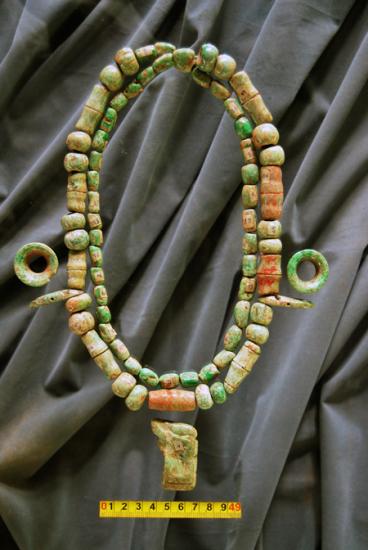Unique discovery of jade necklace from ancient Mayan ruler at Tak’alik Ab’aj
Source - http://www.guatemala-times.com/archeology/takalik-abaj/2813-unique-discovery-of-jade-necklace-from-ancient-mayan-ruler-at-takalik-abaj.html

Guatemala, Rethaluleu, Asintal. Takálik Ab´aj. Discovery of the necklace of the ancestor of the Mayan- Señor de la Greca - Lord of the Fret Design, the Return to the ancestor at Tak’alik Ab’aj. This is the latest finding at the ancient city of Tak'alik Ab'aj. Tak'alik Ab'aj fulfilled for almost two millenniums, a rich and vigorous role in Mesoamerican history.
The sculptured monuments buried there through the centuries, whose tops still emerge from the ground, gave way to the name, which in the K'iche' language means Standing Stone. Tak'alik Ab'aj is an ancient pre-Hispanic city situated in El Asintal, Department of Retalhuleu at the pacific piedmont of Guatemala. This important long distance trade and cosmopolitan cultural center is transcendent because of its long history which endured 1700 years (800 B.C. - 900 A.D). At its beginnings Tak'alik Ab'aj interacted and participated with the Olmec culture, and at its surmise, was one of the protagonists in the development of the early Maya culture.

Deep inside Structure 6, one of the most important ceremonial buildings of the Central Group at Tak’alik Ab’aj, in 2011 the team of the National Archaeological Park Tak’alik Ab’aj, lead by archaeologists Christa Schieber de Lavarreda and Miguel Orrego Corzo of the Guatemalan head office for Cultural and Natural Heritage, Ministry of Culture and Sports, concluded with the excavation of a very special offering yielding a necklace of more than 70 beads of jadeite of different forms and outstanding beauty. This “Necklace offering” is situated more than 4 m at the bottom of the building and was deposited there between 190 b.C. and 10 a.D. (Late Preclassic); it is the most ancient of a series of ritual acts succeeding each other through centuries orbiting around one same vertical axis. This sequence of extraordinary offerings apparently corresponds to dedication rituals to the different architectonic versions from Late Preclassic to Early Classic.

The “Necklace offering”, due to its special nature, appears to represent the departing point to which are focused the subsequent later offerings. Among those, highlights the notorious “Jadeite mosaic offering” which build the two miniature ceremonial heads discovered in 2010 (see news Guatemala-Times 10 of May 2010http://www.guatemala-times.com/archeology/takalik-abaj/1555-mysterious-mayan-ceremonial-head-found-at-takaalik-abaaj-.htm), giving place to the creation of the allegoric name – “Señor de la Greca” (“Lord of the Fret design”) – for a personage which must have had been one of the most powerful rulers of Tak’alik Ab’aj. At the archaeological site of this ancient city various cases of evidences have been found which tell us about the act of returning or referring to the parting points or ancestral orientations, or “calling into presence” the ancestors themselves. In the present case, the “Necklace offering” may refer to the ancestor of the powerful ruler named “Señor de la Greca” (Lord of the Fret design).

The characteristics of the “Necklace offering” invite to think about the possibility that it may represent the burial of an infant or more plausibly an exhumation undertaken in Late Preclassic times, introduced into the middle preclassic version of Structure 6. The extraordinary beauty and quality of the jadeite necklace manifests an utmost expression of status, and the radiocarbon date of 190 b.C. to 10 a.D. of the content of a vessel at the southern end of the space framed by cobble stones in the manner of a very narrow cist, situates this offering or possible burial – 100 years prior to the magnificent royal burial No. 1 discovered some years ago at Tak’alik Ab’aj – as one of the earliest with such an outstanding piece of jewelry.
This date might go even further back in time, possibly Middle Preclassic if the interpretation as an exhumation can be confirmed, which would put into evidence even more the magnitude of this kind of early manifestation of power at Tak’alik Ab’aj.
With this purpose, this year analysis of the presence of calcium and phosphor traces in the material directly associated to the necklace will be undertaken with the cooperation of the Department of Archaeology and Chemistry of University del Valle of Guatemala, as well as the archaeologists expect to be able to date some organic remains.
With this last finding a new precious “bead” has been added to the “necklace” of the most significant discoveries in the last years at Tak’alik Ab’aj, and which have brought us closer to the possible actors behind those historic events and whose signature remains manifest in their material legacy. Some of these personages were immortalized in some of the sculptures at Tak’alik Ab’aj, and their names and important dates of their lives as rulers were sculpted in stone. But it has not been possible to decode those ancient texts, so these personages have made themselves acquainted to the archaeologists by means of their public buildings and artistic expressions.
Pictures described in sequence as they appear.
Picture 1 and 2
The royal ancestor necklace which pieces have been reassembled exactly following the careful documented drawings at the place of discovery.
Picture 3,4,5
The jadeite necklace offering at its place where it was discovered at the bottom of the ceremonial building Structure 6.
Images are published with the permisssion of:
Proyecto Nacional Tak’alik Ab’aj, Ministerio de Cultura y Deportes, Dirección General del Patrimonio Cultural y Natural, Instituto de Antropología e Historia.
Christa Schieber de Lavarreda and Miguel Orrego Corzo. Parque Arqueológico Nacional Tak’alik Ab’aj. Ministerio de Cultura y Deportes. Vice-Ministerio del Patrimonio Cultural y Natural. Dirección General del Patrimonio Cultural y Natural – IDAEH. christaschieber@gmail.com